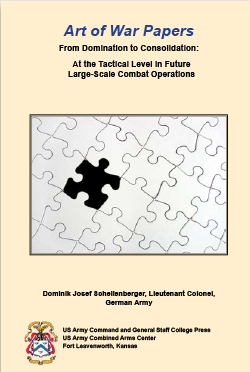
At the Tactical Level in Future Large-Scale Combat Operations
Dominik Josef Schellenberger, Lieutenant Colonel, German Army
140 Pages
Published: 2020
The current operational environment is characterized by the emergence of the information age and peer and near peer adversaries. The 2017 Field Manual (FM) 3-0, Operations addresses those paradigm shifts by introducing the multi-domain extended battlefield and four Army strategic roles-shape, prevent, conduct large-scale ground combat, and consolidate gains.
FM 3-0 officially implements consolidation of gains and the related consolidation area for the first time into US Army doctrine. The purpose of consolidation of gains is to make enduring any temporary operational success and set the conditions for a stable environment allowing for a transition of control to legitimate authorities. An analysis of the historical role the US Army played at the end of World War II for the transition in occupied Germany as well as of current doctrine and future-oriented concepts leads to eighteen suggested doctrinal changes concerning consolidation of gains across US Army operations, leadership, and mission command doctrine.
Four of those suggested doctrinal changes are the introduction of a comprehensive multi-domain consolidation area, the emphasis of intent-guided procedural control, the codification of virtual and cognitive consolidation of gains, and the doctrinal recognition of the possible need for temporary military government.
Download the PDF 